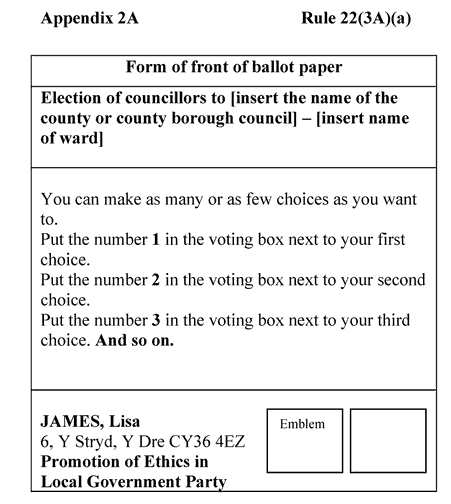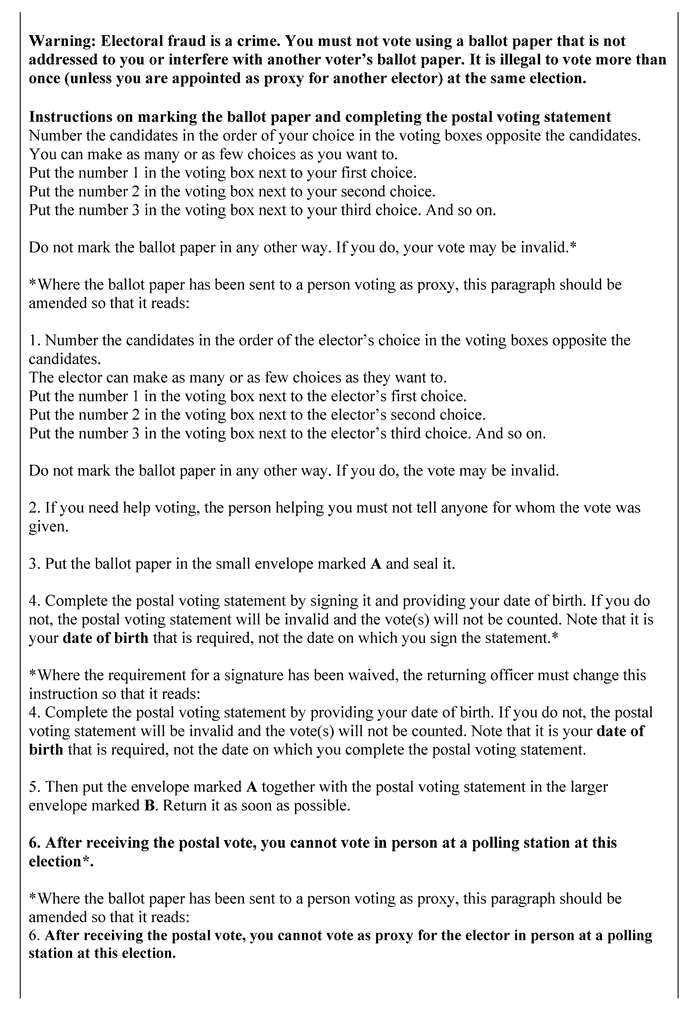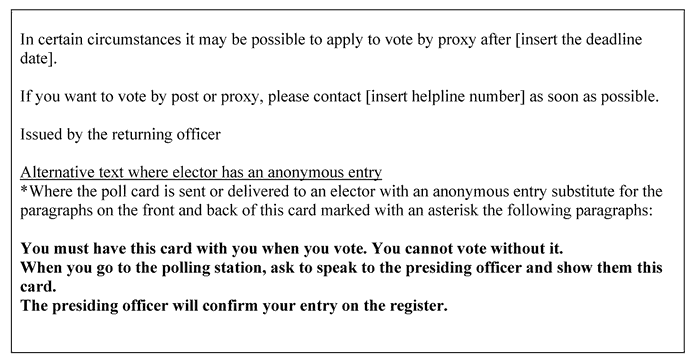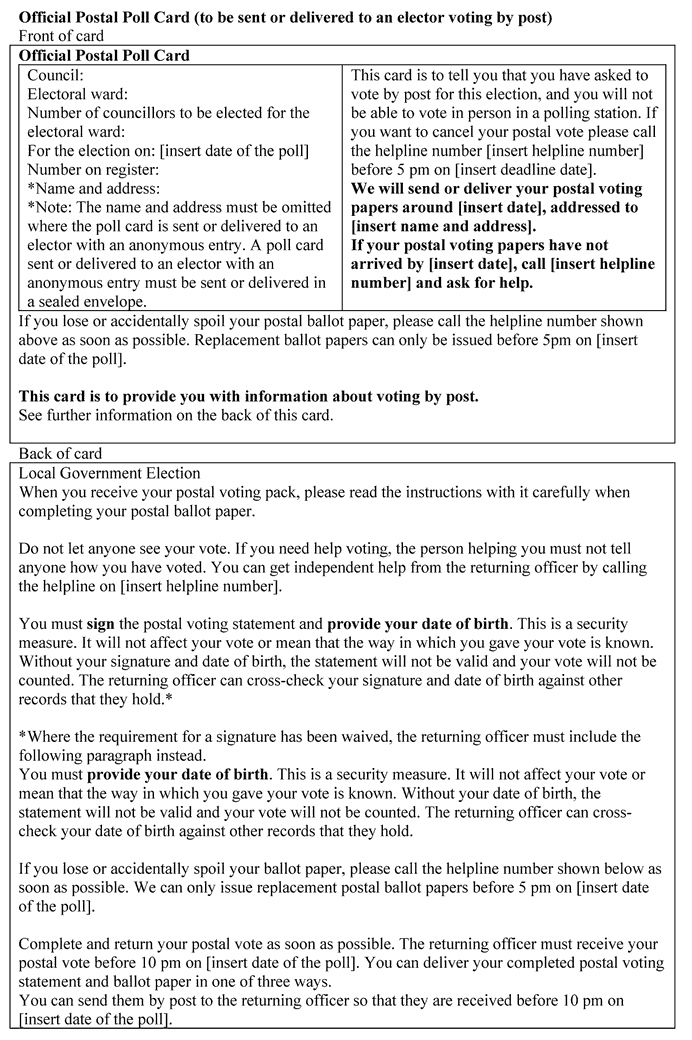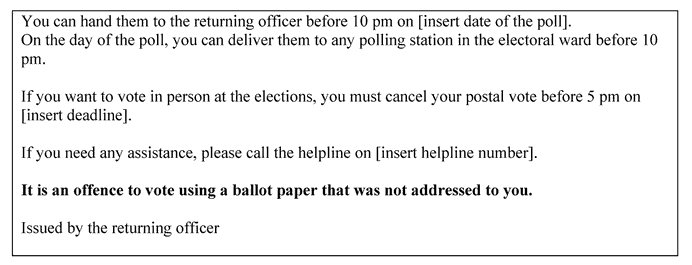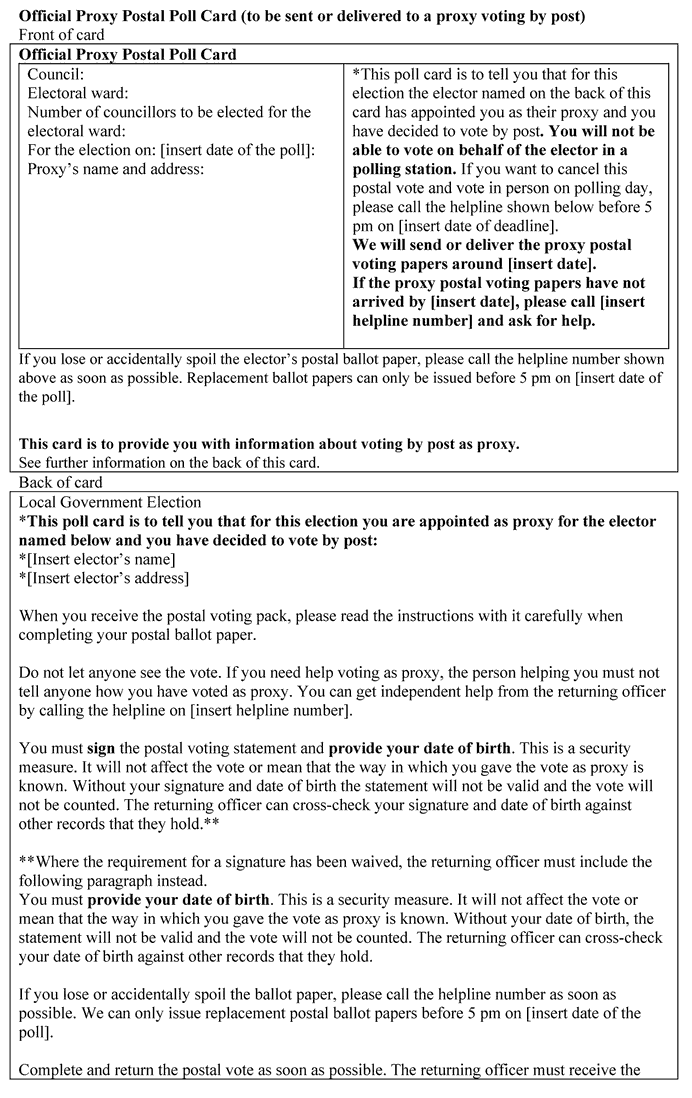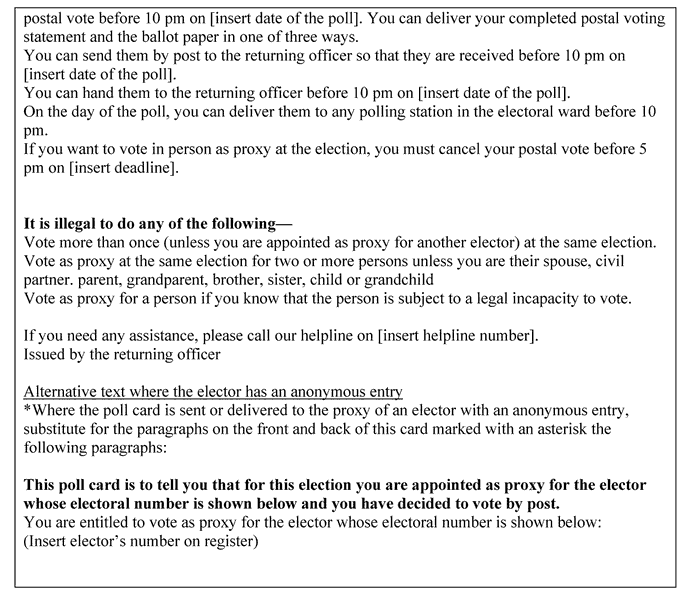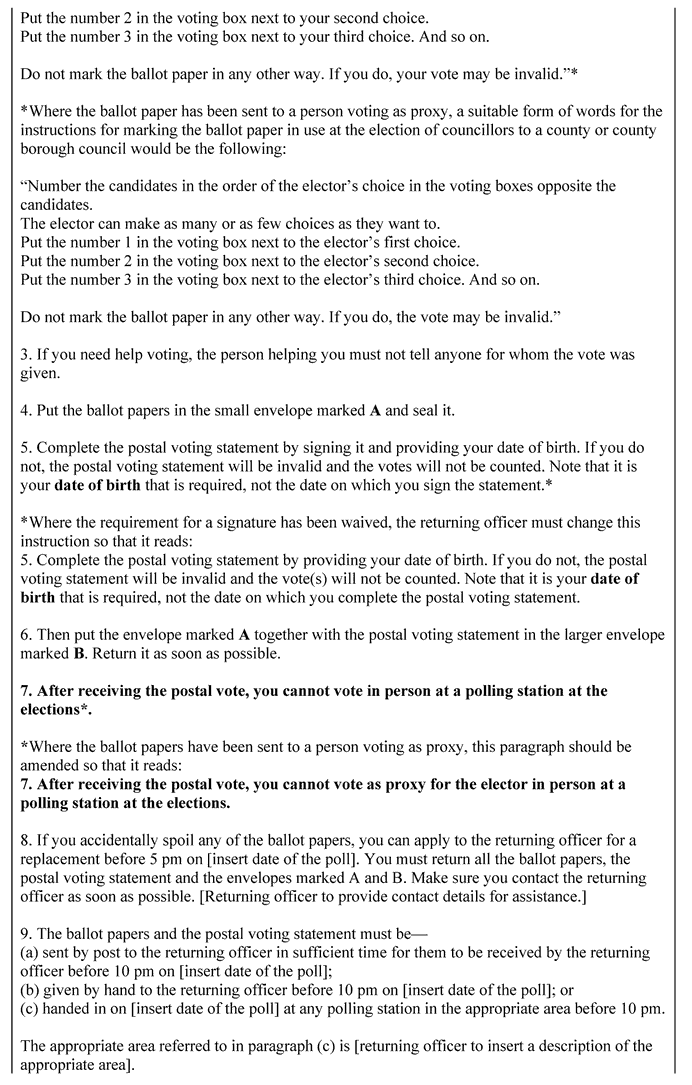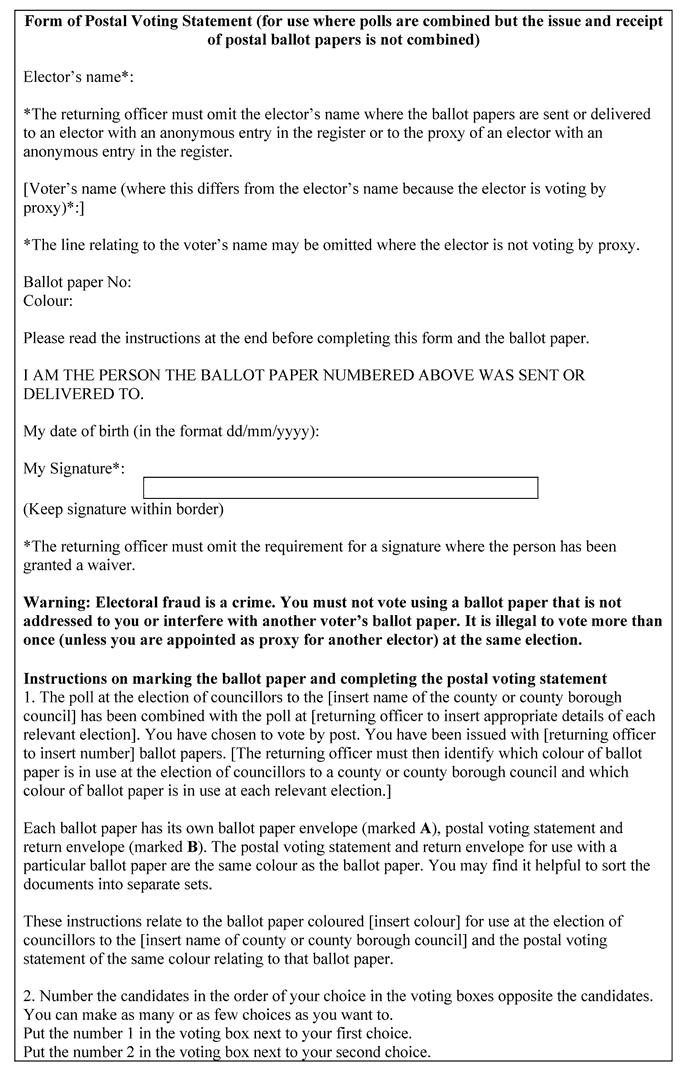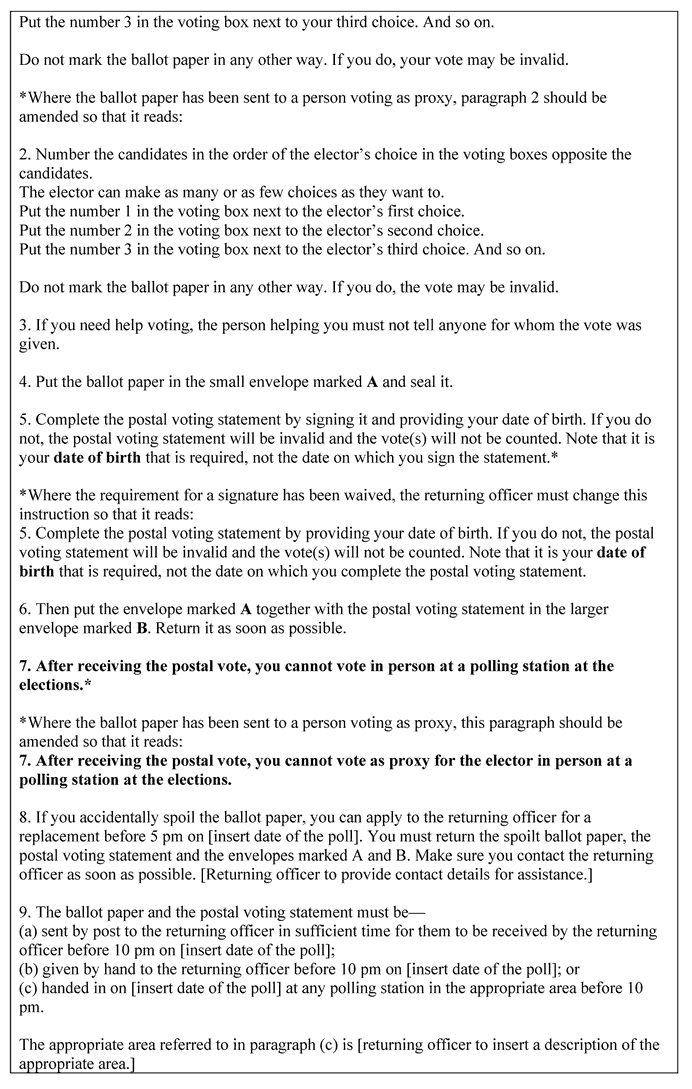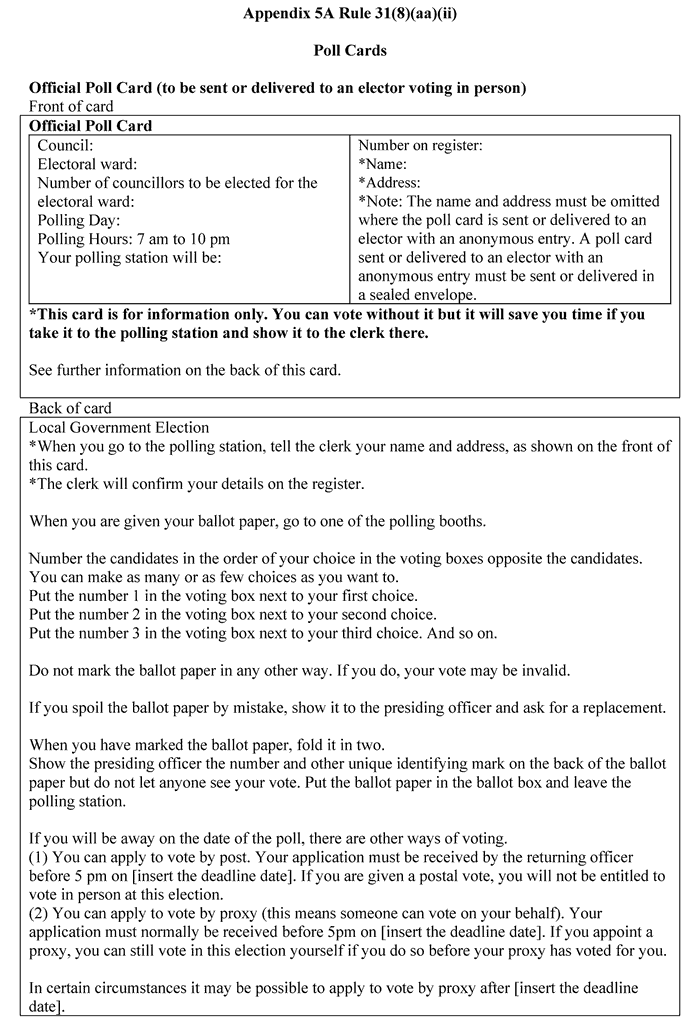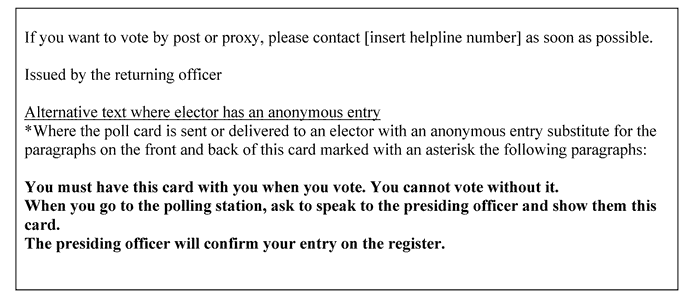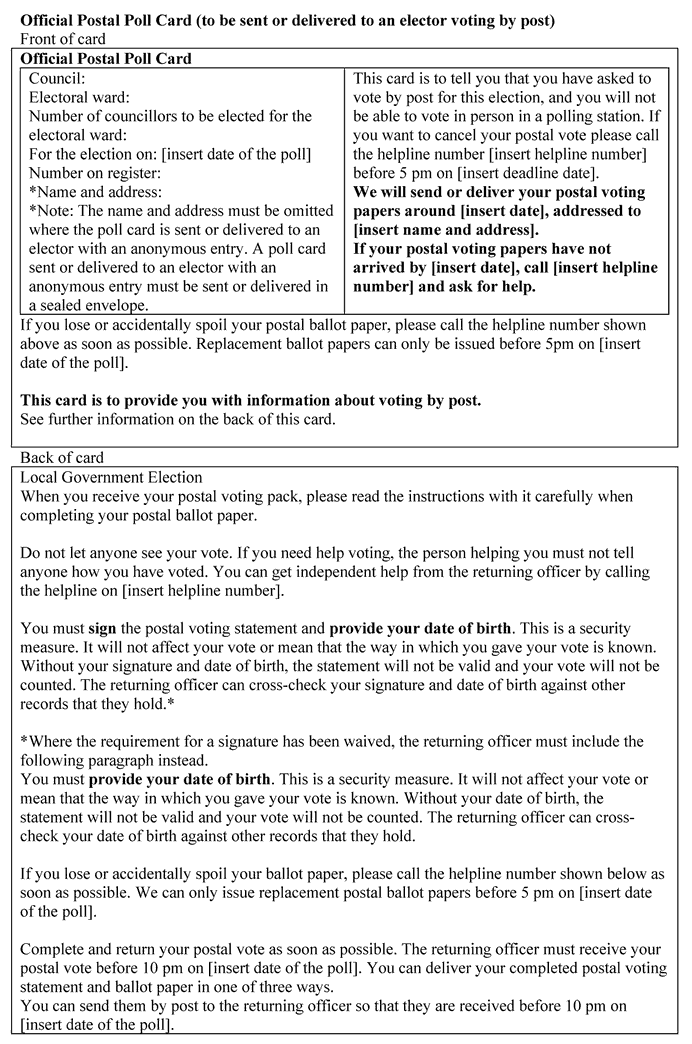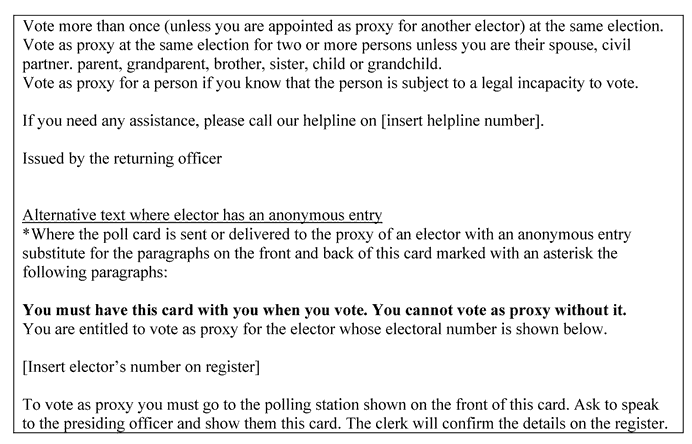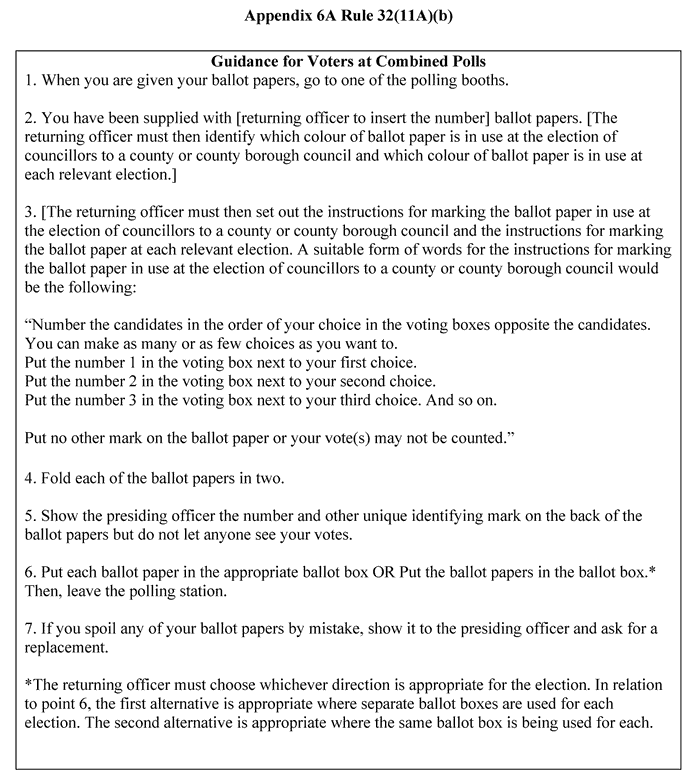Welsh Statutory Instruments
2023 No. 1064 (W. 180)
Local Government, Wales
Representation Of The People, Wales
The Local Elections (Principal Areas) (Single Transferable Vote) (Wales) Rules 2023
Coming into force
9 October 2023
The Welsh Ministers, in exercise of the powers conferred by section 36A(1), (2)(d), and (4) of the Representation of the People Act 1983(), make the following Rules.
In accordance with section 36A(7) of that Act, the Welsh Ministers have consulted such persons as they considered appropriate.
In accordance with section 36A(10) of that Act, a draft of this instrument has been laid before, and approved by a resolution of, Senedd Cymru.
Title, coming into force and interpretation
1.—(1) The title of these Rules is the Local Elections (Principal Areas) (Single Transferable Vote) (Wales) Rules 2023.
(2) These Rules come into force on 9 October 2023.
(3) In these Rules, “the 2021 Rules” means the Local Elections (Principal Areas) (Wales) Rules 2021().
Amendment of rule 3 of the 2021 Rules
2. In rule 3 of the 2021 Rules (interpretation), in paragraph (3)—
(a)in the words in brackets, for “section 202(1)” substitute “sections 202(1) and 203(1)”;
(b)insert at the appropriate places—
““simple majority system” (“system mwyafrif syml”);”
““single transferable vote system” (“system pleidlais sengl drosglwyddadwy”)”.
Amendment of Part 3 of Schedule 1 to the 2021 Rules
3.—(1) Part 3 of Schedule 1 to the 2021 Rules is amended as follows.
(2) In rule 21 (poll to be taken by ballot), for paragraph (2), substitute—
“(2) The result must be ascertained—
(a)where the voting system that applies at the election is the simple majority system, in accordance with Part 4;
(b)where the voting system that applies at the election is the single transferable vote system, in accordance with Part 4A.”.
(3) In rule 22 (the ballot papers)—
(a)in paragraph (3), at the beginning insert “Where the voting system that applies at the election is the simple majority system,”;
(b)after paragraph (3) insert—
“(3A) Where the voting system that applies at the election is the single transferable vote system, a ballot paper must be—
(a)in the form in Appendix 2A, and
(b)printed in accordance with the directions in that Appendix.”.
(4) In rule 28 (postal ballot papers)—
(a)in paragraph (1)(b), for “Appendix 4” substitute “the applicable Appendix”;
(b)after paragraph (1) insert—
“(1A) In paragraph (1)(b), “the applicable Appendix” means—
(a)where the voting system that applies at the election is the simple majority system, Appendix 4;
(b)where the voting system that applies at the election is the single transferable vote system, Appendix 4A.”.
(5) In rule 31 (issue of official poll cards)—
(a)in paragraph (4), for “Appendix 5” substitute “the applicable Appendix”;
(b)in paragraph (6)(a), for “Appendix 5” substitute “the applicable Appendix”;
(c)in paragraph (7), before sub-paragraph (a) insert—
“(aa)“the applicable Appendix” means—
(i)where the voting system that applies at the election is the simple majority system, Appendix 5;
(ii)where the voting system that applies at the election is the single transferable vote system, Appendix 5A.”.
(6) In rule 32 (equipment of polling stations)—
(a)in paragraph (9), for “Appendix 6” substitute “the applicable Appendix”;
(b)after paragraph (9) insert—
“(9A) In paragraph (9), “the applicable Appendix” means—
(a)where the voting system that applies at the election is the simple majority system, Appendix 6;
(b)where the voting system that applies at the election is the single transferable vote system, Appendix 6A.”;
(c)in paragraph (11), at the beginning insert “Where the voting system that applies at the election is the simple majority system,”;
(d)after paragraph (11) insert—
“(12) Where the voting system that applies at the election is the single transferable vote system, a notice containing the following information must be exhibited inside each voting compartment in each polling station—
(a)an instruction to the voter to put the number 1 in the voting box next to their first choice;
(b)an explanation to the voter that they may make as many or as few additional choices as they wish, together with an instruction on how to do this by putting the number 2 next to their second choice, the number 3 next to their third choice and so on.”.
Insertion of Part 4A of Schedule 1 to the 2021 Rules
4.—(1) For the heading of Part 4 of Schedule 1 to the 2021 Rules substitute—
“Counting of Votes: Elections Using the Simple Majority System ”.
(2) At the end of Part 4 insert—
“Part 4ACounting of Votes: Elections Using the Single Transferable Vote System
CHAPTER 1Introductory provisions
Arrangements for the counting of votes
60A.—(1) The returning officer must make arrangements for the votes to be counted in the presence of the counting agents as soon as practicable after the close of the poll.
(2) The returning officer must give the counting agents a notice stating the time and place at which the returning officer will begin to count the votes.
Attendance at the counting of votes
60B.—(1) The following persons are entitled to be present at the counting of votes—
(a)the returning officer and members of the returning officer’s staff;
(b)each candidate and a guest of each candidate;
(c)the election agents;
(d)the counting agents;
(e)any person who is entitled to attend by virtue of sections 6A to 6D of the Political Parties, Elections and Referendums Act 2000() (representatives of the Electoral Commission and accredited observers);
(f)the constables on duty.
(2) The returning officer may permit any other person to attend at the counting of votes.
(3) Permission may not be given under paragraph (2) unless the returning officer—
(a)is satisfied that the person’s attendance will not impede the efficient counting of votes, and
(b)has either consulted the election agents about whether to give permission or decided that it is not practicable to consult them.
(4) The returning officer must give the counting agents all such reasonable facilities for overseeing the proceedings, and all such information about them, as the returning officer is able to give consistently with the orderly conduct of the proceedings and the discharge of the returning officer’s duties.
(5) In particular, where the votes are counted by sorting the ballot papers according to the candidate for whom first preferences are given and then counting the number of ballot papers for each candidate, the counting agents are entitled to satisfy themselves that the ballot papers are correctly sorted.
(6) The returning officer must make arrangements to ensure that every person attending at the counting of votes (other than the constables on duty) has been given a notice setting out the provisions of section 66(2) and (6) of the 1983 Act() (notification of requirement of secrecy).
(7) In this rule, a reference to a constable includes a reference to a person designated as a community support officer or community support volunteer under section 38 of the Police Reform Act 2002() (police powers for civilian staff and volunteers).
The count: steps
60C.—(1) The returning officer must take the following steps.
(2) The returning officer must, in the presence of the counting agents, open each ballot box, take out the ballot papers, count them and record the number of ballot papers.
(3) The returning officer must not count any tendered ballot paper.
(4) The returning officer must, in the presence of the election agents, verify each ballot paper account by comparing it with the number of ballot papers recorded, the unused and spoilt ballot papers in the returning officer’s possession and the tendered votes list (opening and resealing the packets containing the unused and spoilt ballot papers and tendered votes list).
(5) The returning officer must prepare a statement as to the result of the verification and give a copy of the statement to any election agent who requests it.
(6) The returning officer must also—
(a)count the postal ballot papers that have been properly returned (see paragraph (7)), and
(b)record the number counted.
(7) A postal ballot paper is to be treated as properly returned if the ballot paper and the accompanying postal voting statement properly completed are—
(a)handed in at a polling station in the electoral ward before the close of the poll,
(b)given by hand to the returning officer before the close of the poll, or
(c)received by the returning officer by post before the close of the poll.
(8) A postal voting statement is properly completed if—
(a)it is signed by the elector or (as the case may be) the proxy, unless the registration officer has dispensed with the requirement for a signature,
(b)it states the date of birth of the elector or (as the case may be) the proxy, and
(c)in a case where steps for verifying the date of birth and signature of an elector or proxy have been prescribed by regulations under the 1983 Act(), the returning officer has taken those steps and verified the date of birth and (except in a case where the requirement for a signature has been dispensed with) the signature.
(9) Where, at the close of the poll, a person is in the polling station, or in a queue outside the polling station, for the purpose of handing in a postal ballot paper and postal voting statement—
(a)the person must be permitted to hand the ballot paper and statement in at the polling station, and
(b)where handed in, they are to be treated as having been handed in before the close of the poll for the purposes of this rule.
(10) The returning officer must not count the votes given on any ballot paper until—
(a)in the case of postal ballot papers, they have been mixed with the ballot papers from at least one ballot box, and
(b)in the case of ballot papers from a ballot box, they have been mixed with the ballot papers from at least one other ballot box.
(11) While counting and recording the number of ballot papers and counting the votes, the returning officer must—
(a)keep the ballot papers with their faces upwards, and
(b)take such other precautions as are appropriate for preventing any person from seeing the numbers or other unique identifying marks printed on the back of the papers.
The count: general
60D.—(1) Subject to paragraph (2), the returning officer must, so far as practicable, proceed continuously with the counting of votes until all vacancies have been filled, allowing only time for refreshment.
(2) The returning officer may exclude any hours between 7 p.m. and 9 a.m. on the following morning.
(3) During any time that is excluded, the returning officer must—
(a)place the ballot papers and other documents relating to the election under the returning officer’s seal and the seals of any counting agents who wish to affix their seals, and
(b)otherwise take proper precautions for the security of the ballot papers and other documents.
The count: rejected ballot papers
60E.—(1) Subject to paragraph (2), the following ballot papers are void and must not be counted—
(a)a ballot paper that does not bear the official mark;
(b)a ballot paper on which the figure “1” standing alone is not placed so as to indicate a first preference for some candidate;
(c)a ballot paper on which the figure “1” standing alone indicating a first preference is set opposite the name of more than one candidate;
(d)a ballot paper on which anything is written or marked by which the voter can be identified except the printed number and other unique identifying mark on the back;
(e)a ballot paper that is unmarked or void for uncertainty.
(2) Paragraph (3) applies to a ballot paper on which a vote is marked—
(a)elsewhere than in the proper place, or
(b)otherwise than by the use of words or any other mark instead of a figure.
(3) The ballot paper is not, by reason only of how the vote is marked, to be treated as void if, in the returning officer’s opinion, it is clear from the ballot paper that the voter clearly indicated a preference or preferences.
(4) The returning officer must endorse the word “rejected” on any ballot paper which, in accordance with this rule, is not to be counted.
(5) If a counting agent objects to the returning officer’s decision, the returning officer must add the words “rejection objected to” to the endorsement.
(6) The returning officer must prepare a statement showing the number of ballot papers rejected.
(7) The statement must set out the number rejected under each of sub-paragraphs (a) to (e) of paragraph (1).
CHAPTER 2Ascertaining the Result
Interpretation
60F. In this Chapter—
“continuing candidate” (“ymgeisydd sy’n parhau”) means any candidate who is not already treated as elected and is not excluded under rule 60O;
“count” (“cyfrif”) means all the operations involved in the counting of first preferences recorded for candidates, the transfer of transferable papers from candidates who are treated as elected and have a surplus and the transfer of transferable papers from candidates who are excluded under rule 60O;
“next available preference” (“dewis nesaf sydd ar gael”) means a preference which is the second or subsequent preference in consecutive order for a continuing candidate (and therefore does not include a preference for a candidate who is treated as elected or a preference for a candidate who is excluded under rule 60O);
“quota” (“cwota”) means the number calculated in accordance with rule 60H;
“stage of the count” (“cam o’r cyfrif”) means—
(a)
the determination of the first preference votes for each candidate;
(b)
the transfer of the transferrable papers of a candidate who is treated as elected and has a surplus (see rules 60J and 60K);
(c)
the exclusion of one or more candidates at any given time (see rule 60O);
“surplus” (“pleidleisiau dros ben”) means the number of votes by which the total number of votes for any candidate exceeds the quota.
Counting of first preference votes
60G.—(1) The returning officer must sort the valid ballot papers into groups according to the candidates for whom first preference votes are given.
(2) The returning officer must then—
(a)count the number of ballot papers in each group, and
(b)record those numbers.
(3) The returning officer must also ascertain and record the total number of valid ballot papers.
Determining the quota
60H. The returning officer must take the following steps to determine the number of votes sufficient to secure the return of a candidate as a councillor (“the quota”).
Step 1
Take the total number of valid ballot papers recorded for the electoral ward under rule 60G(3).
Step 2
Take the number of councillors to be elected for the electoral ward and add one.
Step 3
Divide the number taken at step 1 by the number taken at step 2. If the result of the division contains decimal places, ignore them.
Step 4
Add one to the result of the division at step 3 (ignoring any decimals). This number is the quota.
Return of councillors
60I.—(1) Where, at any stage of the count, the number of votes for a candidate equals or exceeds the quota, the candidate is treated as elected.
(2) For the purpose of determining whether the number of first preference votes for any candidate equals or exceeds the quota, the candidate is to be credited with one vote for each ballot paper on which a first preference vote is given for the candidate.
(3) Rules 60J, 60K, 60O and 60P make provision about the number of votes to be credited to a candidate where a ballot paper on which a second or subsequent preference for the candidate is transferred to the candidate in accordance with those rules.
(4) A candidate who is treated as elected is returned as a councillor when the returning officer declares the candidate to be elected in accordance with rule 60W.
(5) For the meaning of “quota”, see rule 60F.
Transfers where first preference votes exceed the quota
60J.—(1) This rule applies where the number of first preference votes for a candidate exceeds the quota.
(2) The returning officer must sort all the ballot papers on which first preference votes are given for the candidate so that they are grouped—
(a)according to the continuing candidate for whom the next available preference is given on those papers, or
(b)where no next available preference is given, as a separate group.
The ballot papers in the groups formed under paragraph (a) (“transferable papers”) are to be transferred in accordance with paragraphs (4) and (5) of this rule. The ballot papers in the group formed under paragraph (b) (“non-transferable papers”) are not to be transferred.
(3) The returning officer must count the number of ballot papers in each group of transferable papers and in the group of non-transferable papers.
(4) The returning officer must then transfer each group of transferable papers to the continuing candidate for whom the next available preference is given on those papers.
(5) The vote on each transferable paper is transferred at a value (“the transfer value”) which is calculated by taking the following steps.
Step 1
Take the surplus of the candidate from whom ballot papers are being transferred.
Step 2
Divide the surplus by the total number of ballot papers being transferred. Make the calculation to two decimal places and ignore the remainder. This is the transfer value.
(6) For the meaning of “continuing candidate”, “next available preference”, “quota” and “surplus”, see rule 60F.
(7) See also—
rule 60L (which sets out circumstances in which votes are not to be transferred under this rule);
rule 60M (which sets out the order in which surpluses are to be transferred where two or more candidates have surpluses);
rule 60N (which makes supplementary provision).
Other transfers where votes exceed the quota
60K.—(1) This rule applies where, at the end of any stage of the count involving the transfer of ballot papers, the number of votes for a candidate exceeds the quota.
(2) The returning officer must sort all the ballot papers in the group of transferred papers last received by that candidate so that they are grouped—
(a)according to the continuing candidate for whom the next available preference is given on those papers, or
(b)where no next available preference is given, as a separate group.
The ballot papers in the groups formed under paragraph (a) (“transferable papers”) are to be transferred in accordance with paragraphs (4) and (5) of this rule. The ballot papers in the group formed under paragraph (b) (“non-transferable papers”) are not to be transferred.
(3) The returning officer must count the number of ballot papers in each group of transferable papers and in the group of non-transferable papers.
(4) The returning officer must then transfer each group of transferable papers to the continuing candidate for whom the next available preference is given on those papers.
(5) The vote on each transferable paper is transferred at a value (“the transfer value”) which is calculated by taking the following steps.
Step 1
Take the surplus of the candidate from whom ballot papers are being transferred.
Step 2
Divide the surplus by the total number of ballot papers being transferred. Make the calculation to two decimal places and ignore the remainder.
Step 3
Compare the number arrived at following step 2 to the value the vote on the ballot paper had when it was received by the candidate from whom ballot papers are now being transferred.
If the number arrived at following step 2 is less than or the same as the value of the vote on the ballot paper when it was received by that candidate, that number is the transfer value.
If the number arrived at following step 2 is greater than the value of the vote on the ballot paper when it was received by that candidate, the value of the vote when it was received by that candidate is the transfer value.
(6) For the meaning of “continuing candidate”, “next available preference”, “quota” and “surplus”, see rule 60F.
(7) See also—
rule 60L (which sets out circumstances in which votes are not to be transferred under this rule);
rule 60M (which sets out the order in which surpluses are to be transferred where two or more candidates have surpluses);
rule 60N (which makes supplementary provision).
Circumstances in which votes are not transferred under rule 60J or 60K
60L.—(1) Subject to paragraphs (2) and (3), the returning officer must continue to make transfers under rules 60J and 60K until—
(a)there is no candidate who is treated as elected who has a surplus, or
(b)all the vacancies have been filled (after the application, where relevant, of rule 60S).
(2) Transferable papers are not to be transferred where, at any stage of the count, a surplus (or, where two or more candidates have surpluses, the total of those surpluses) is less than the difference between—
(a)the number of votes then credited to the continuing candidate with the lowest number of votes, and
(b)the number of votes then credited to the continuing candidate who is next above that candidate.
(3) Transferable papers are not to be transferred where, at any stage of the count, a surplus (or, where two or more candidates have surpluses, the total of those surpluses) is less than the difference between—
(a)the total number of votes then credited to the two or more continuing candidates with the lowest number of votes, and
(b)the number of votes then credited to the continuing candidate who is next above those candidates.
(4) Rules 60J and 60K do not apply at an election where there is only one vacancy.
(5) For the meaning of “continuing candidate” and “surplus”, see rule 60F.
Order of transfers under rules 60J and 60K
60M.—(1) If, at any stage of the count, two or more candidates have surpluses that are to be dealt with under rule 60J or 60K, the transferable papers of the candidate with the largest surplus must be transferred first.
(2) If the surpluses in respect of two or more candidates are equal, the transferable papers of the candidate who had the highest number of votes at the earliest stage of the count at which they had unequal votes must be transferred first.
(3) If the votes credited to two or more candidates were equal at all stages of the count—
(a)the returning officer must decide between those candidates by lot, and
(b)the transferable papers of the candidate on whom the lot falls must be transferred first.
(4) For the meaning of “surplus”, see rule 60F.
Transfers under rules 60J and 60K: supplementary provision
60N.—(1) Each transfer under rule 60J or 60K of all transferable papers from a candidate who has a surplus constitutes a stage in the count.
(2) The returning officer must, on the completion of that stage—
(a)record the total transfer value of the votes transferred to each candidate,
(b)add that value to the previous total of votes recorded for each candidate and record the new total,
(c)record as non-transferable votes the difference between the surplus and the total transfer value of the transferred votes, and
(d)add that difference to the previously recorded total of non-transferable votes.
(3) The returning officer must then compare—
(a)the total number of votes then recorded for all the candidates, together with the total number of non-transferable votes, with
(b)the recorded total of valid first preference votes.
(4) All ballot papers transferred under rule 60J or 60K must be clearly marked, either individually or as a group, so as to indicate the transfer value at which the vote on the paper is transferred or, as the case may be, the transfer value of all the votes on the papers in that group.
(5) The returning officer must include a ballot paper in the group of non-transferable papers formed under rule 60J or 60K(2) if—
(a)the returning officer is of the opinion that the ballot paper indicates that the preference next in the order of preference has been given to two or more candidates (whether or not consecutive candidates),
(b)the returning officer is of the opinion that the next preference on the ballot paper (whether or not for a continuing candidate) does not follow consecutively after the preference immediately before it, or
(c)it is unclear to the returning officer for any other reason which candidate is next in the order of preference.
(6) For the meaning of “surplus”, see rule 60F.
Exclusion of candidates and transfer of first preference ballot papers
60O.—(1) This rule applies where—
(a)the returning officer has transferred all the transferable papers that the returning officer is required to transfer under any provision of this Chapter, and
(b)one or more vacancies remain to be filled (after the application, where relevant, of rule 60S).
(2) Subject to paragraph (3), the returning officer must exclude from the election at that stage the candidate with the then lowest number of votes.
(3) The returning officer must exclude two or more candidates with the lowest number of votes where the total number of those candidates’ votes, together with any surpluses that have not been transferred, is less than the number of votes then credited to the candidate who is next above those candidates.
(4) The returning officer must sort all the ballot papers on which first preference votes are given for the candidate or candidates who are excluded so that they are grouped—
(a)according to the continuing candidate for whom the next available preference is given on those papers, or
(b)where no next available preference is given, as a separate group.
The ballot papers in the groups formed under paragraph (a) (“transferable papers”) are to be transferred in accordance with this rule. The ballot papers in the group formed under paragraph (b) (“non-transferable papers”) are not to be transferred.
(5) The returning officer must transfer each group of transferable papers to the continuing candidate for whom the next available preference is given on those papers.
(6) The vote on each transferable paper is transferred at a transfer value, which is the value of 1.
(7) Where the returning officer has completed the transfers required by paragraph (5) and one or more vacancies remain to be filled (after the application where relevant of rule 60S), the returning officer must next act in accordance with rule 60P.
(8) Paragraph (7) applies whether or not any candidate is treated as elected following the transfers and has a surplus.
(9) For the meaning of “continuing candidate”, “next available preference” and “surplus”, see rule 60F.
(10) See also—
rule 60Q (which deals with the order of exclusion where more than one candidate has the lowest number of votes);
rule 60R (which makes supplementary provision).
Transfer of excluded candidates’ other ballot papers
60P.—(1) This rule applies where—
(a)the returning officer has transferred all the transferable papers of an excluded candidate or candidates that the returning officer is required to transfer under rule 60O, and
(b)one or more vacancies remain to be filled (after the application where relevant of rule 60S).
(2) The returning officer must sort all the ballot papers, if any, which were transferred to the excluded candidate (or any of the excluded candidates) at an earlier stage in the count into groups according to the transfer value at which the votes on the ballot papers were received by that candidate.
(3) The returning officer must then sort the ballot papers in the group of ballot papers with votes of the highest transfer value into further groups as follows—
(a)according to the continuing candidate for whom the next available preference is given on those papers, or
(b)where no next available preference is given, as a separate group.
The ballot papers in the groups formed under paragraph (a) (“transferable papers”) are to be transferred in accordance with this rule. The ballot papers in the group formed under paragraph (b) (“non-transferable papers”) are not to be transferred.
(4) The returning officer must transfer each group of transferable papers to the continuing candidate for whom the next available preference is given on those papers.
(5) The vote on each transferable paper is transferred at a transfer value, which is the value at which the vote on the ballot paper was received by the excluded candidate from whom the paper is being transferred.
(6) Where the returning officer has completed the transfers required by paragraph (4) and one or more vacancies remain to be filled (after the application where relevant of rule 60S), the returning officer must repeat the steps in paragraphs (3) to (5) in relation to the remaining groups of ballot papers formed under paragraph (2), dealing with each group in descending order according to the value of the votes until either—
(a)there are no remaining vacancies to be filled (after the application where relevant of rule 60S), or
(b)every group has been dealt with.
(7) Paragraph (6) applies whether or not any candidate is treated as elected and has a surplus following the completion of the steps in paragraphs (3) to (5) in relation to the group of ballot papers with votes of the highest transfer value or in relation to any of the remaining groups.
(8) In a case where every group of ballot papers formed under paragraph (2) has been dealt with but one or more vacancies remain to be filled (after the application where relevant of rule 60S), the returning officer must proceed as follows—
(a)in accordance with rule 60K if one or more candidates treated as elected following the transfer of ballot papers under rule 60O or this rule has a surplus, and
(b)otherwise in accordance with rule 60O.
(9) For the meaning of “continuing candidate”, “next available preference” and “surplus”, see rule 60F.
(10) See also rule 60R (which makes supplementary provision).
Order of exclusion
60Q.—(1) This rule applies where—
(a)the returning officer is deciding which candidate to exclude under rule 60O(2),
(b)two or more candidates each have the same number of votes, and
(c)no other candidate has fewer votes.
(2) The returning officer must exclude whichever of the candidates had the lowest number of votes at the earliest stage of the count at which they had an unequal number of votes.
(3) Where the number of votes credited to the candidates was equal at all stages, the returning officer must—
(a)decide between the candidates by lot, and
(b)the candidate on whom the lot falls must be excluded.
Exclusion of candidates: supplementary provision
60R.—(1) The exclusion of a candidate, or of two or more candidates together, under rule 60O constitutes a further stage of the count.
(2) The returning officer must take the following steps after the completion of the transfer of transferable papers under rule 60O(5) or after a group of ballot papers formed under rule 60P(2) has been dealt with in accordance with rule 60P(3) to (5)—
(a)record the total value of votes transferred to each candidate under rule 60O(5) or 60P(4);
(b)add that total to the previous total of votes recorded for each candidate and record the new total,
(c)record the value of the votes in the groups of non-transferable papers formed under rule 60O(4) or 60P(3), and
(d)add that value to the previously recorded total of non-transferable votes.
(3) The returning officer must then compare—
(a)the total number of votes then recorded for each candidate together with the total number of non-transferable votes, with
(b)the recorded total of valid first preference votes.
(4) All ballot papers transferred under rule 60O(5) or 60P(4) must be clearly marked, either individually or as a group, so as to indicate the transfer value at which the vote on the paper is transferred or, as the case may be, the transfer value of all the votes on the papers in that group.
(5) The returning officer must include a ballot paper in the group of non-transferable papers formed under rule 60O(4) or 60P(3) if—
(a)the returning officer is of the opinion that the ballot paper indicates that the preference next in the order of preference has been given to two or more candidates (whether or not consecutive candidates),
(b)the returning officer is of the opinion that the next preference on the ballot paper (whether or not for a continuing candidate) does not follow consecutively after the preference immediately before it, or
(c)it is unclear to the returning officer for any other reason which candidate is next in the order of preference.
Filling of last vacancies
60S.—(1) Where the number of continuing candidates is equal to the number of vacancies remaining unfilled, the continuing candidates are treated as elected.
(2) Where only one vacancy remains unfilled, the continuing candidate then credited with the highest number of votes must be treated as elected if that number of votes is equal to or greater than the total number of votes then credited to the other continuing candidates together with any surpluses not transferred.
(3) Where the last vacancies can be filled under this rule, no further transfer of votes may be made.
(4) For the meaning of “continuing candidate” and “surplus”, see rule 60F.
Re-count
60T.—(1) The returning officer, on completion of each stage of the count, must inform all the candidates and their election agents then present of the intention, subject to a request for a re-count, to proceed to the next stage.
(2) Before the returning officer proceeds, any candidate or election agent present at the count may request that a re-count be undertaken of the last completed stage.
(3) The returning officer must comply with the request unless the returning officer’s opinion is that the request is unreasonable.
(4) If no request is made the returning officer must proceed with the next stage of the count.
(5) Where, as a result of a re-count an error is discovered, the returning officer must, where necessary, amend any results that have been previously announced.
Order of election of candidates
60U.—(1) The order in which candidates whose vote exceeds the quota are treated as elected is the order in which their respective surpluses were transferred or would have been transferred but for rule 60L(2) or (3).
(2) A candidate credited with a number of votes equal to the quota is to be placed (in the order of those treated as elected) after any other candidates treated as elected at the same time who had surpluses.
(3) For the meaning of “quota” and “surplus”, see rule 60F.
Decisions on ballot papers
60V. The decision of the returning officer on any question arising in respect of a ballot paper, the transfer of ballot papers or the exclusion of candidates is final, but may be reviewed on an election petition.
Declaration of result at contested election
60W.—(1) Where all stages of the count have been completed, the returning officer must declare to be elected the candidates who have been treated as elected under this Chapter.
(2) The returning officer must give a notice stating the names and addresses of the candidates elected to the proper officer of the council for which the election was held.
(3) The returning officer must also publish notice of—
(a)the names of the candidates elected;
(b)the number of first and subsequent preferences for each candidate (whether elected or not);
(c)the number of ballot papers transferred and their transfer values at each stage of the count;
(d)the number of votes credited to each candidate at each stage of the count;
(e)the number of non-transferable ballot papers and the number of non-transferable votes at each stage of the count;
(f)the number of rejected ballot papers under each head shown in the statement of rejected ballot papers.”.
Amendment of Part 5 of Schedule 1 to the 2021 Rules
5. In rule 62 (delivery of documents to registration officer at contested elections) in Schedule 1 to the 2021 Rules—
(a)in paragraph (2)(c), after “rule 56(7)” insert “or rule 60E(6)”;
(b)in paragraph (2)(d), after “rule 54(5)” insert “or rule 60C(5)”.
Amendment of Appendices to Schedule 1 to the 2021 Rules
6.—(1) The Appendices to Schedule 1 to the 2021 Rules are amended as follows.
(2) After Appendix 2 insert Appendix 2A as set out in Schedule 1.
(3) After Appendix 4 insert Appendix 4A as set out in Schedule 2.
(4) After Appendix 5 insert Appendix 5A as set out in Schedule 3.
(5) After Appendix 6 insert Appendix 6A as set out in Schedule 4.
Amendment of Part 3 of Schedule 2 to the 2021 Rules
7.—(1) Part 3 of Schedule 2 to the 2021 Rules is amended as follows.
(2) In rule 21 (poll to be taken by ballot), for paragraph (2), substitute—
“(2) The result must be ascertained—
(a)where the voting system that applies at the election is the simple majority system, in accordance with Part 4;
(b)where the voting system that applies at the election is the single transferable vote system, in accordance with Part 4A.”.
(3) In rule 22 (the ballot papers)—
(a)in paragraph (3), at the beginning insert “Where the voting system that applies at the election is the simple majority system,”;
(b)after paragraph (3) insert—
“(3A) Where the voting system that applies at the election is the single transferable vote system, a ballot paper must be—
(a)in the form in Appendix 2A, and
(b)printed in accordance with the directions in that Appendix.”.
(4) In rule 28 (postal ballot papers)—
(a)in paragraph (1)(b), for “Appendix 4” substitute “the applicable Appendix”;
(b)after paragraph (1) insert—
“(1A) In paragraph (1)(b), “the applicable Appendix” means—
(a)where the voting system that applies at the election is the simple majority system, Appendix 4;
(b)where the voting system that applies at the election is the single transferable vote system, Appendix 4A.”.
(5) In rule 31 (issue of official poll cards)—
(a)in paragraph (4), for “Appendix 5” substitute “the applicable Appendix”;
(b)in paragraph (6)(a), for “Appendix 5” substitute “the applicable Appendix”;
(c)in paragraph (8), before sub-paragraph (a) insert—
“(aa)“the applicable Appendix” means—
(i)where the voting system that applies at the election is the simple majority system, Appendix 5;
(ii)where the voting system that applies at the election is the single transferable vote system, Appendix 5A.”.
(6) In rule 32 (equipment of polling stations)—
(a)in paragraph (11), for “Appendix 6” substitute “the applicable Appendix”;
(b)after paragraph (11) insert—
“(11A) In paragraph (11), “the applicable Appendix” means—
(a)where the voting system that applies at the election is the simple majority system, Appendix 6;
(b)where the voting system that applies at the election is the single transferable vote system, Appendix 6A.”;
(c)in paragraph (13), at the beginning insert “Where the voting system that applies at the election is the simple majority system,”;
(d)after paragraph (13) insert—
“(13A) Where the voting system that applies at the election is the single transferable vote system, a notice containing instructions for marking the ballot paper at the principal area election and each relevant election must be exhibited inside each voting compartment in each polling station and, in relation to the principal area election, that information must include the following—
(a)an instruction to the voter to put the number 1 in the voting box next to their first choice;
(b)an explanation to the voter that they may make as many or as few additional choices as they wish, together with an instruction on how to do this by putting the number 2 next to their second choice, the number 3 next to their third choice and so on.”.
Insertion of Part 4A of Schedule 2 to the 2021 Rules
8.—(1) For the heading of Part 4 of Schedule 2 to the 2021 Rules substitute—
“Counting of Votes: Elections using the Simple Majority System ”.
(2) At the end of Part 4 insert—
“Part 4ACounting of Votes: Elections Using the Single Transferable Vote System
CHAPTER 1Introductory Provisions
Overview of rules and interpretation
64A.—(1) This rule provides an overview of the application of this Part.
(2) Where the returning officer is the co-ordinating returning officer, the following rules apply—
(a)rule 64B (attendance at proceedings);
(b)rule 64C (preliminary and general duties);
(c)rule 64D (separation of ballot papers etc.);
(d)the rules in Chapter 2 (ascertaining the result).
(3) Where the returning officer is not the co-ordinating returning officer, the following rules apply—
(a)rule 64B(1) and (3) to (8) (attendance at proceedings);
(b)rule 64E (preliminary and general duties);
(c)rule 64F (opening of containers etc.);
(d)the rules in Chapter 2 (ascertaining the result).
(4) In this Part—
(a)references to the principal area counting agents are to the counting agents appointed for the purposes of the principal area election;
(b)references to the other counting agents are to the counting agents appointed for the purposes of any relevant election;
(c)references to the principal area election agents are to the election agents appointed for the purposes of the principal area election;
(d)references to the other election agents are to the election agents appointed for the purposes of any relevant election.
Attendance at proceedings under this Part
64B.—(1) The following persons are entitled to attend proceedings under rules 64D(2) to (10) and 64F and under the rules in Chapter 2—
(a)the returning officer and members of the returning officer’s staff;
(b)each candidate and a guest of each candidate;
(c)the principal area election agents;
(d)the principal area counting agents;
(e)any person who is entitled to attend by virtue of sections 6A to 6D of the Political Parties, Elections and Referendums Act 2000 (representatives of the Electoral Commission and accredited observers);
(f)the constables on duty.
(2) In addition, any person who is entitled to attend the counting of votes at a relevant election is entitled to attend proceedings under rule 64D(2) to (10).
(3) The returning officer may permit any other person to attend proceedings under any of rules 64D(2) to (10) or 64F or under any of the rules in Chapter 2.
(4) Permission may not be given under paragraph (3) unless the returning officer—
(a)is satisfied that the person’s attendance will not impede the efficient discharge of the returning officer’s functions, and
(b)has either consulted the appropriate persons about whether to give permission or decided that it is not practicable to consult them.
(5) For the purposes of paragraph (4)(b), “the appropriate persons” are—
(a)in the case of proceedings under rule 64D(2) to (10), the principal area election agents and the other election agents;
(b)in the case of any other proceedings, the principal area election agents.
(6) The returning officer must give any counting agents who are entitled to attend all such reasonable facilities for overseeing the proceedings, and all such information about them, as the returning officer is able to give consistently with the orderly conduct of the proceedings and the discharge of the returning officer’s duties.
(7) In particular, where the votes are counted by sorting the ballot papers according to the candidate for whom first preferences are given and then counting the number of ballot papers for each candidate, the principal area counting agents are entitled to satisfy themselves that the ballot papers are correctly sorted.
(8) The returning officer must make arrangements to ensure that every person attending at the counting of votes (other than the constables on duty) has been given a notice setting out the provisions of section 66(2) and (6) of the 1983 Act (notification of requirement of secrecy).
(9) In this rule, a reference to a constable includes a reference to a person designated as a community support officer or community support volunteer under section 38 of the Police Reform Act 2002 (police powers for civilian staff and volunteers).
Preliminary and general duties where returning officer is co-ordinating returning officer
64C.—(1) This rule applies where the returning officer is the co-ordinating returning officer.
(2) The returning officer must make arrangements for discharging the functions under rule 64D as soon as practicable after the close of the poll.
(3) The returning officer must give the principal area counting agents and the other counting agents a notice stating the time and place at which the returning officer will begin to discharge the functions under rule 64D.
(4) While counting and recording the number of ballot papers and counting the votes, the returning officer must—
(a)keep the ballot papers with their faces upwards, and
(b)take such other precautions as are appropriate for the purpose of preventing any person from seeing the numbers or other unique identifying marks printed on the back of the papers.
Separation of ballot papers etc. where returning officer is co-ordinating returning officer
64D.—(1) This rule applies where the returning officer is the co-ordinating returning officer.
(2) The returning officer must, in the presence of the principal area counting agents and the other counting agents—
(a)open each ballot box and take out the ballot papers,
(b)separate the ballot papers according to the election at which they were used,
(c)count the ballot papers used at each election, and
(d)record separately the number of ballot papers used at each election.
(3) The returning officer must not count any tendered ballot paper.
(4) Where separate ballot boxes were used at the poll, no vote for a candidate at the principal area election is to be treated as invalid because it was placed in the ballot box intended for use at a relevant election.
(5) The returning officer must, in the presence of the principal area election agents and the other election agents, verify each ballot paper account by comparing it with the number of ballot papers recorded, the unused and spoilt ballot papers in the returning officer’s possession and the tendered votes list (opening and resealing the packets containing the unused and spoilt ballot papers and tendered votes list).
(6) The returning officer must prepare a statement as to the result of the verification and give a copy of the statement to any principal area election agent, and to any other election agent, who requests it.
(7) The returning officer must also—
(a)count the postal ballot papers that have been properly returned (as to which see rule 64G), and
(b)record separately the number counted at the poll at the principal area election and at each relevant election.
(8) The returning officer must then—
(a)make up into packets the ballot papers for each relevant election, and
(b)seal up the packets in separate containers endorsing on each a description of the area to which the ballot papers relate.
(9) The returning officer must then deliver or cause to be delivered to the returning officer for each relevant election—
(a)the containers of ballot papers relating to the election, together with a list of the containers and their contents,
(b)the ballot paper accounts relating to the election, together with a copy of the statements as to the result of the verification, and
(c)the packets of unused and spoilt ballot papers and tendered ballot papers.
(10) The returning officer must then mix together all the ballot papers used at the principal area election.
Preliminary and general duties where returning officer is not the co-ordinating returning officer
64E.—(1) This rule applies where the returning officer is not the co-ordinating returning officer.
(2) The returning officer must make arrangements for counting the votes in the presence of the principal area counting agents as soon as practicable after the delivery of the ballot papers by the returning officer who is the co-ordinating returning officer.
(3) The returning officer must give the principal area counting agents a notice stating the time when the counting of votes will begin (on the assumption that the ballot papers have been delivered) and the place at which the count will take place.
(4) While counting and recording the number of ballot papers and counting the votes, the returning officer must—
(a)keep the ballot papers with their faces upwards, and
(b)take such other precautions as are appropriate for the purpose of preventing any person from seeing the numbers or other unique identifying marks printed on the back of the papers.
Opening of containers etc. where returning officer is not the co-ordinating returning officer
64F.—(1) This rule applies where the returning officer is not the co-ordinating returning officer.
(2) On receipt of the containers of ballot papers from the returning officer who is the co-ordinating returning officer, and after the time specified in the notice given under rule 64E(3), the returning officer must open each container in the presence of the principal area counting agents.
(3) Where the proceedings on the issue and receipt of postal ballot papers are not taken together with those proceedings at a relevant election under regulation 65 of the Representation of the People (England and Wales) Regulations 2001() or under that regulation as applied by regulations under section 44 of the Local Government Act 2000(), the returning officer must count the postal ballot papers that have been properly returned and record the number counted.
(4) The returning officer must then mix together all the postal ballot papers and all the ballot papers from the containers.
Further provision about postal ballot papers
64G.—(1) This rule applies for determining whether a postal ballot paper is to be treated as properly returned as mentioned in rules 64D(7)(a) and 64F(3).
(2) A postal ballot paper is to be treated as properly returned if the ballot paper and the accompanying postal voting statement properly completed are—
(a)handed in at a polling station in the appropriate area before the close of the poll,
(b)given by hand to the returning officer before the close of the poll, or
(c)received by the returning officer by post before the close of the poll.
(3) A postal voting statement is properly completed if—
(a)it is signed by the elector or (as the case may be) the proxy, unless the registration officer has dispensed with the requirement for a signature,
(b)it states the date of birth of the elector or (as the case may be) the proxy, and
(c)in a case where steps for verifying the date of birth and signature of an elector or proxy have been prescribed by regulations under the 1983 Act, the returning officer has taken those steps and verified the date of birth and (except in a case where the requirement for a signature has been dispensed with) the signature.
(4) Where, at the close of the poll, a person is in the polling station, or in a queue outside the polling station, for the purpose of handing in a postal ballot paper and postal voting statement—
(a)the person must be permitted to hand the ballot paper and statement in at the polling station, and
(b)where handed in, they are to be treated as having been handed in before the close of the poll for the purposes of this rule.
(5) “The appropriate area” referred to in paragraph (2)(a) is the area which is identified by—
(a)establishing the polls in respect of which the postal voter has been issued with a ballot paper,
(b)identifying the constituency or other area in respect of which each of those polls is being held, and
(c)then identifying the area that is common to all those areas.
The count: general
64H.—(1) This rule applies where the returning officer has mixed the ballot papers under rule 64D(10) or 64F(4).
(2) Subject to paragraph (3), the returning officer must, so far as practicable, proceed continuously with the counting of votes until all vacancies have been filled, allowing only time for refreshment.
(3) The returning officer may exclude any hours between 7 p.m. and 9 a.m. on the following morning.
(4) During any time that is excluded, the returning officer must—
(a)place the ballot papers and other documents relating to the election under the returning officer’s seal and the seals of any principal area counting agents who wish to affix their seals, and
(b)otherwise take proper precautions for the security of the ballot papers and other documents.
The count: rejected ballot papers
64I.—(1) Subject to paragraph (2), the following ballot papers are void and must not be counted—
(a)a ballot paper that does not bear the official mark;
(b)a ballot paper on which the figure “1” standing alone is not placed so as to indicate a first preference for some candidate;
(c)a ballot paper on which the figure “1” standing alone indicating a first preference is set opposite the name of more than one candidate;
(d)a ballot paper on which anything is written or marked by which the voter can be identified except the printed number and other unique identifying mark on the back;
(e)a ballot paper that is unmarked or void for uncertainty.
(2) Paragraph (3) applies to a ballot paper on which a vote is marked—
(a)elsewhere than in the proper place, or
(b)otherwise than by the use of words or any other mark instead of a figure.
(3) The ballot paper is not, by reason only of how the vote is marked, to be treated as void if, in the returning officer’s opinion, it is clear from the ballot paper that the voter clearly indicated a preference or preferences.
(4) The returning officer must endorse the word “rejected” on any ballot paper which, in accordance with this rule, is not to be counted.
(5) If a counting agent objects to the returning officer’s decision, the returning officer must add the words “rejection objected to” to the endorsement.
(6) The returning officer must prepare a statement showing the number of ballot papers rejected.
(7) The statement must set out the number rejected under each of sub-paragraphs (a) to (e) of paragraph (1).
CHAPTER 2Ascertaining the Result
Application and interpretation
64J. In this Chapter—
“continuing candidate” (“ymgeisydd sy’n parhau”) means any candidate who is not already treated as elected and is not excluded under rule 64S;
“count” (“cyfrif”) means all the operations involved in the counting of first preferences recorded for candidates, the transfer of transferable papers from candidates who are treated as elected and have a surplus, and the transfer of transferable papers from candidates who are excluded under rule 64S;
“next available preference” (“dewis nesaf sydd ar gael”) means a preference which is the second or subsequent preference in consecutive order for a continuing candidate (and therefore does not include a preference for a candidate who is treated as elected or a preference for a candidate who is excluded under rule 64S);
“quota” (“cwota”) means the number calculated in accordance with rule 64L;
“stage of the count” (“cam o’r cyfrif”) means—
(a)
the determination of the first preference votes for each candidate;
(b)
the transfer of the transferrable papers of a candidate who is treated as elected and has a surplus (see rules 64N and 64O);
(c)
the exclusion of one or more candidates at any given time (see rule 64S);
“surplus” (“pleidleisiau dros ben”) means the number of votes by which the total number of votes for any candidate exceeds the quota.
Counting of first preference votes
64K.—(1) The returning officer must sort the valid ballot papers into groups according to the candidates for whom first preference votes are given.
(2) The returning officer must then—
(a)count the number of ballot papers in each group, and
(b)record those numbers.
(3) The returning officer must also ascertain and record the total number of valid ballot papers.
Determining the quota
64L. The returning officer must take the following steps to determine the number of votes sufficient to secure the return of a candidate as a councillor (“the quota”).
Step 1
Take the total number of valid ballot papers recorded for the electoral ward under rule 64K(3).
Step 2
Take the number of councillors to be elected for the electoral ward and add one.
Step 3
Divide the number taken at step 1 by the number taken at step 2. If the result of the division contains decimal places, ignore them.
Step 4
Add one to the result of the division at step 3 (ignoring any decimals). This number is the quota.
Return of councillors
64M.—(1) Where, at any stage of the count, the number of votes for a candidate equals or exceeds the quota, the candidate is treated as elected.
(2) For the purpose of determining whether the number of first preference votes for any candidate equals or exceeds the quota, the candidate is to be credited with one vote for each ballot paper on which a first preference vote is given for the candidate.
(3) Rules 64N, 64O, 64S and 64T make provision about the number of votes to be credited to a candidate where a ballot paper on which a second or subsequent preference for the candidate is transferred to the candidate in accordance with those rules.
(4) A candidate who is treated as elected is returned as a councillor when the returning officer declares the candidate to be elected in accordance with rule 64Z1.
(5) For the meaning of “quota”, see rule 64J.
Transfers where first preference votes exceed the quota
64N.—(1) This rule applies where the number of first preference votes for a candidate exceeds the quota.
(2) The returning officer must sort all the ballot papers on which first preference votes are given for the candidate so that they are grouped—
(a)according to the continuing candidate for whom the next available preference is given on those papers, or
(b)where no next available preference is given, as a separate group.
The ballot papers in the groups formed under paragraph (a) (“transferable papers”) are to be transferred in accordance with paragraphs (4) and (5) of this rule. The ballot papers in the group formed under paragraph (b) (“non-transferable papers”) are not to be transferred.
(3) The returning officer must count the number of ballot papers in each group of transferable papers and in the group of non-transferable papers.
(4) The returning officer must then transfer each group of transferable papers to the continuing candidate for whom the next available preference is given on those papers.
(5) The vote on each transferable paper is transferred at a value (“the transfer value”) which is calculated by taking the following steps.
Step 1
Take the surplus of the candidate from whom ballot papers are being transferred.
Step 2
Divide the surplus by the total number of ballot papers being transferred. Make the calculation to two decimal places and ignore the remainder. This is the transfer value.
(6) For the meaning of “continuing candidate”, “next available preference”, “quota” and “surplus”, see rule 64J.
(7) See also—
rule 64P (which sets out circumstances in which votes are not to be transferred under this rule);
rule 64Q (which sets out the order in which surpluses are to be transferred where two or more candidates have surpluses);
rule 64R (which makes supplementary provision).
Other transfers where votes exceed the quota
64O.—(1) This rule applies where, at the end of any stage of the count involving the transfer of ballot papers, the number of votes for a candidate exceeds the quota.
(2) The returning officer must sort all the ballot papers in the group of transferred papers last received by that candidate so that they are grouped—
(a)according to the continuing candidate for whom the next available preference is given on those papers, or
(b)where no next available preference is given, as a separate group.
The ballot papers in the groups formed under paragraph (a) (“transferable papers”) are to be transferred in accordance with paragraphs (4) and (5) of this rule. The ballot papers in the group formed under paragraph (b) (“non-transferable papers”) are not to be transferred.
(3) The returning officer must count the number of ballot papers in each group of transferable papers and in the group of non-transferable papers.
(4) The returning officer must then transfer each group of transferable papers to the continuing candidate for whom the next available preference is given on those papers.
(5) The vote on each transferable paper is transferred at a value (“the transfer value”) which is calculated by taking the following steps.
Step 1
Take the surplus of the candidate from whom ballot papers are being transferred.
Step 2
Divide the surplus by the total number of ballot papers being transferred. Make the calculation to two decimal places and ignore the remainder.
Step 3
Compare the number arrived at following step 2 to the value of the vote on the ballot paper had when it was received by the candidate from whom ballot papers are now being transferred.
If the number arrived at following step 2 is less than or the same as the value of the vote on the ballot paper when it was received by that candidate, that number is the transfer value.
If the number arrived at following step 2 is greater than the value of the vote on the ballot paper when it was received by that candidate, the value of the vote when it was received by that candidate is the transfer value.
(6) For the meaning of “continuing candidate”, “next available preference”, “quota” and “surplus”, see rule 64J.
(7) See also—
rule 64P (which sets out circumstances in which votes are not to be transferred under this rule);
rule 64Q (which sets out the order in which surpluses are to be transferred where two or more candidates have surpluses);
rule 64R (which makes supplementary provision).
Circumstances in which votes are not transferred under rule 64N or 64O
64P.—(1) Subject to paragraphs (2) and (3), the returning officer must continue to make transfers under rules 64N and 64O until—
(a)there is no candidate who is treated as elected who has a surplus, or
(b)all the vacancies have been filled (after the application, where relevant, of rule 64W).
(2) Transferable papers are not to be transferred where, at any stage of the count, a surplus (or, where two or more candidates have surpluses, the total of those surpluses) is less than the difference between—
(a)the number of votes then credited to the continuing candidate with the lowest number of votes, and
(b)the number of votes then credited to the continuing candidate who is next above that candidate.
(3) Transferable papers are not to be transferred where, at any stage of the count, a surplus (or, where two or more candidates have surpluses, the total of those surpluses) is less than the difference between—
(a)the total number of votes then credited to the two or more continuing candidates with the lowest number of votes, and
(b)the number of votes then credited to the continuing candidate who is next above those candidates.
(4) Rules 64N and 64O do not apply at an election where there is only one vacancy.
(5) For the meaning of “continuing candidate” and “surplus”, see rule 64J.
Order of transfers under rules 64N and 64O
64Q.—(1) If, at any stage of the count, two or more candidates have surpluses that are to be dealt with under rule 64N or 64O, the transferable papers of the candidate with the largest surplus must be transferred first.
(2) If the surpluses in respect of two or more candidates are equal, the transferable papers of the candidate who had the highest number of votes at the earliest stage of the count at which they had unequal votes must be transferred first.
(3) If the votes credited to two or more candidates were equal at all stages of the count—
(a)the returning officer must decide between those candidates by lot, and
(b)the transferable papers of the candidate on whom the lot falls must be transferred first.
(4) For the meaning of “surplus”, see rule 64J.
Transfers under rules 64N and 64O: supplementary provision
64R.—(1) Each transfer under rule 64N or 64O of all transferable papers from a candidate who has a surplus constitutes a stage in the count.
(2) The returning officer must, on the completion of that stage—
(a)record the total transfer value of the votes transferred to each candidate,
(b)add that value to the previous total of votes recorded for each candidate and record the new total,
(c)record as non-transferable votes the difference between the surplus and the total transfer value of the transferred votes, and
(d)add that difference to the previously recorded total of non-transferable votes.
(3) The returning officer must then compare—
(a)the total number of votes then recorded for all the candidates, together with the total number of non-transferable votes, with
(b)the recorded total of valid first preference votes.
(4) All ballot papers transferred under rule 64N or 64O must be clearly marked, either individually or as a group, so as to indicate the transfer value at which the vote on the paper is transferred or, as the case may be, the transfer value of all the votes on the papers in that group.
(5) The returning officer must include a ballot paper in the group of non-transferable papers formed under rule 64N(2) or 64O(2) if—
(a)the returning officer is of the opinion that the ballot paper indicates that the preference next in the order of preference has been given to two or more candidates (whether or not consecutive candidates),
(b)the returning officer is of the opinion that the next preference on the ballot paper (whether or not for a continuing candidate) does not follow consecutively after the preference immediately before it, or
(c)it is unclear to the returning officer for any other reason which candidate is next in the order of preference.
(6) For the meaning of “surplus”, see rule 64J.
Exclusion of candidates and transfer of first preference ballot papers
64S.—(1) This rule applies where—
(a)the returning officer has transferred all the transferable papers that the returning officer is required to transfer under any provision of this Chapter, and
(b)one or more vacancies remain to be filled (after the application, where relevant, of rule 64W).
(2) Subject to paragraph (3), the returning officer must exclude from the election at that stage the candidate with the then lowest number of votes.
(3) The returning officer must exclude two or more candidates with the lowest number of votes where the total number of those candidates’ votes, together with any surpluses that have not been transferred, is less than the number of votes then credited to the candidate who is next above those candidates.
(4) The returning officer must sort all the ballot papers on which first preference votes are given for the candidate or candidates who are excluded so that they are grouped—
(a)according to the continuing candidate for whom the next available preference is given on those papers, or
(b)where no next available preference is given, as a separate group.
The ballot papers in the groups formed under paragraph (a) (“transferable papers”) are to be transferred in accordance with this rule. The ballot papers in the group formed under paragraph (b) (“non-transferable papers”) are not to be transferred.
(5) The returning officer must transfer each group of transferable papers to the continuing candidate for whom the next available preference is given on those papers.
(6) The vote on each transferable paper is transferred at a transfer value, which is the value of 1.
(7) Where the returning officer has completed the transfers required by paragraph (5) and one or more vacancies remain to be filled (after the application where relevant of rule 64W), the returning officer must next act in accordance with rule 64T.
(8) Paragraph (7) applies whether or not any candidate is treated as elected following the transfers and has a surplus.
(9) For the meaning of “continuing candidate”, “next available preference” and “surplus”, see rule 64J.
(10) See also—
rule 64U (which deals with the order of exclusion where more than one candidate has the lowest number of votes);
rule 64V (which makes supplementary provision).
Transfer of excluded candidates’ other ballot papers
64T.—(1) This rule applies where—
(a)the returning officer has transferred all the transferable papers of an excluded candidate or candidates that the returning officer is required to transfer under rule 64S, and
(b)one or more vacancies remain to be filled (after the application, where relevant, of rule 64W).
(2) The returning officer must sort all the ballot papers, if any, which were transferred to the excluded candidate (or any of the excluded candidates) at an earlier stage in the count into groups according to the transfer value at which the votes were received by that candidate.
(3) The returning officer must then sort the ballot papers in the group of ballot papers with votes of the highest transfer value into further groups as follows—
(a)according to the continuing candidate for whom the next available preference is given on those papers, or
(b)where no next available preference is given, as a separate group.
The ballot papers in the groups formed under paragraph (a) (“transferable papers”) are to be transferred in accordance with paragraphs (4) and (5) of this rule. The ballot papers in the group formed under paragraph (b) (“non-transferable papers”) are not to be transferred.
(4) The returning officer must transfer each group of transferable papers to the continuing candidate for whom the next available preference is given on those papers.
(5) The vote on the ballot paper on each transferable paper is transferred at a transfer value, which is the value at which the vote was received by the excluded candidate from whom the paper is being transferred.
(6) Where the returning officer has completed the transfers required by paragraph (4) and one or more vacancies remain to be filled (after the application where relevant of rule 64W), the returning officer must repeat the steps in paragraphs (3) to (5) in relation to the remaining groups of ballot papers formed under paragraph (2), dealing with each group in descending order according to the value of the votes until either—
(a)there are no remaining vacancies to be filled (after the application where relevant of rule 64W), or
(b)every group has been dealt with.
(7) Paragraph (6) applies whether or not any candidate is treated as elected and has a surplus following the completion of the steps in paragraphs (3) to (5) in relation to the group of ballot papers with votes of the highest transfer value or in relation to any of the remaining groups.
(8) In a case where every group of ballot papers formed under paragraph (2) has been dealt with but (after the application, where relevant, of rule 64W) one or more vacancies remain to be filled, the returning officer must proceed as follows—
(a)in accordance with rule 64O if, at that stage, any candidate is treated as elected and has a surplus, and
(b)otherwise in accordance with rule 64S.
(9) For the meaning of “continuing candidate”, “next available preference” and “surplus”, see rule 64J.
(10) See also rule 64V (which makes supplementary provision).
Order of exclusion
64U.—(1) This rule applies where—
(a)the returning officer is deciding which candidate to exclude under rule 64S(2),
(b)two or more candidates each have the same number of votes, and
(c)no other candidate has fewer votes.
(2) The returning officer must exclude whichever of the candidates had the lowest number of votes at the earliest stage of the count at which they had an unequal number of votes.
(3) Where the number of votes credited to the candidates was equal at all stages, the returning officer must—
(a)decide between the candidates by lot, and
(b)the candidate on whom the lot falls must be excluded.
Exclusion of candidates: supplementary provision
64V.—(1) The exclusion of a candidate, or of two or more candidates together, under rule 64S constitutes a further stage of the count.
(2) The returning officer must take the following steps after the completion of the transfer of transferable papers under rule 64S(5) or after a group of ballot papers formed under rule 64T(2) has been dealt with in accordance with rule 64T(3) to (5)—
(a)record the total value of votes transferred to each candidate under rule 64S(5) or 64T(4);
(b)add that total to the previous total of votes recorded for each candidate and record the new total,
(c)record the value of the votes in the groups of non-transferable papers formed under rule 64S(4) or 64T(3), and
(d)add that value to the previously recorded total of non-transferable votes.
(3) The returning officer must then compare—
(a)the total number of votes then recorded for each candidate together with the total number of non-transferable votes, with
(b)the recorded total of valid first preference votes.
(4) All ballot papers transferred under rule 64S(5) or 64T(4) must be clearly marked, either individually or as a group, so as to indicate the transfer value at which the vote on the paper is transferred or, as the case may be, the transfer value of all the votes on the papers in that group.
(5) The returning officer must include a ballot paper in the group of non-transferable papers formed under rule 64S(4) or 64T(3) if—
(a)the returning officer is of the opinion that the ballot paper indicates that the preference next in the order of preference has been given to two or more candidates (whether or not consecutive candidates),
(b)the returning officer is of the opinion that the next preference on the ballot paper (whether or not for a continuing candidate) does not follow consecutively after the preference immediately before it, or
(c)it is unclear to the returning officer for any other reason which candidate is next in the order of preference.
Filling of last vacancies
64W.—(1) Where the number of continuing candidates is equal to the number of vacancies remaining unfilled, the continuing candidates are treated as elected.
(2) Where only one vacancy remains unfilled, the continuing candidate then credited with the highest number of votes must be treated as elected if that number of votes is equal to or greater than the total number of votes then credited to the other continuing candidates together with any surpluses not transferred.
(3) Where the last vacancies can be filled under this rule, no further transfer of votes may be made.
(4) For the meaning of “continuing candidate” and “surplus”, see rule 64J.
Re-count
64X.—(1) The returning officer, on completion of each stage of the count, must inform all the candidates and their election agents then present of the intention, subject to a request for a re-count, to proceed to the next stage.
(2) Before the returning officer proceeds, any candidate or election agent present at the count may request that a re-count be undertaken of the last completed stage.
(3) The returning officer must comply with the request unless the returning officer’s opinion is that the request is unreasonable.
(4) If no request is made the returning officer must proceed with the next stage of the count.
(5) Where, as a result of a re-count an error is discovered, the returning officer must, where necessary, amend any results that have been previously announced.
Order of election of candidates
64Y.—(1) The order in which candidates whose vote exceeds the quota are treated as elected is the order in which their respective surpluses were transferred or would have been transferred but for rule 64P(2) or (3).
(2) A candidate credited with a number of votes equal to the quota is to be placed (in the order of those treated as elected) after any other candidates treated as elected at the same time who had surpluses.
(3) For the meaning of “quota” and “surplus”, see rule 64J.
Decisions on ballot papers
64Z. The decision of the returning officer on any question arising in respect of a ballot paper, the transfer of ballot papers or the exclusion of candidates is final, but may be reviewed on an election petition.
Declaration of result at contested election
64Z1.—(1) Where all stages of the count have been completed, the returning officer must declare to be elected the candidates who have been treated as elected under this Chapter.
(2) The returning officer must give a notice stating the names and addresses of the candidates elected to the proper officer of the council for which the election was held.
(3) The returning officer must also publish notice of—
(a)the names of the candidates elected;
(b)the number of first and subsequent preferences for each candidate (whether or not elected);
(c)the number of ballot papers transferred and their transfer values at each stage of the count;
(d)the number of votes credited to each candidate at each stage of the count;
(e)the number of non-transferable ballot papers and the number of non-transferable votes at each stage of the count;
(f)the number of rejected ballot papers under each head shown in the statement of rejected ballot papers.”.
Amendment of Part 5 of Schedule 2 to the 2021 Rules
9. In rule 66 (delivery of documents to registration officer at contested elections) of Schedule 2 to the 2021 Rules—
(a)in paragraph (2)(c), after “rule 60(7)” insert “or rule 64I(6)”;
(b)in paragraph (2)(d), after “rule 55(6)” insert “or rule 64D(6)”.
Amendment of Appendices to Schedule 2 to the 2021 Rules
10.—(1) The Appendices to Schedule 2 to the 2021 Rules are amended as follows.
(2) After Appendix 2, insert Appendix 2A as set out in Schedule 5.
(3) After Appendix 4, insert Appendix 4A as set out in Schedule 6.
(4) After Appendix 5, insert Appendix 5A as set out in Schedule 7.
(5) After Appendix 6, insert Appendix 6A as set out in Schedule 8.
Other amendments of the 2021 Rules
11. In rule 54(3) of Schedule 2 to the 2021 Rules, for “rule 56”, substitute “rule 55”.
Rebecca Evans
Minister for Finance and Local Government, one of the Welsh Ministers
4 October 2023
SCHEDULES
Rule 6(2)
SCHEDULE 1
Rule 6(3)
SCHEDULE 2
Rule 6(4)
SCHEDULE 3
Rule 6(5)
SCHEDULE 4
Rule 10(2)
SCHEDULE 5
Rule 10(3)
SCHEDULE 6
Rule 10(4)
SCHEDULE 7
Rule 10(5)
SCHEDULE 8
EXPLANATORY NOTE
On 6 May 2022, the provisions of the Local Government and Elections (Wales) Act 2021 (“the 2021 Act”) relating to the single transferable vote system at the election of councillors to a principal council in Wales came into force. These provisions allow principal councils to decide to conduct elections using the single transferable vote system instead of the simple majority system (see, in particular, sections 7 to 9 of that Act).
Section 13 of the 2021 Act inserted section 36A of the Representation of the People Act 1983, which enables the Welsh Ministers to make rules for the conduct of local government elections in Wales. That power has been exercised to make the Local Elections (Principal Areas) (Wales) Rules 2021 (S.I. 2021/1459 (W. 374)) (“the 2021 Rules”). Those Rules set out how elections to principal councils must be conducted where the simple majority system is in use. They do not make provision for the conduct of elections where the single transferable vote system is in use.
These Rules (the Local Elections (Principal Areas) (Single Transferable Vote) (Wales) Rules 2023) therefore amend the 2021 Rules so that they provide for the conduct of elections where the single transferable vote system is in use. The 2021 Rules will continue to make provision about the simple majority system for the conduct of elections in principle areas which have not decided to use the single transferable vote system.
Rule 2 amends rule 3 of the 2021 Rules so that the terms “simple majority system” and “single transferable vote system” are added to the list in paragraph (3) of that rule. The effect of the amendment is that those terms have the meaning set out in section 6 of the 2021 Act.
Rule 3 amends Part 3 of Schedule 1 to the 2021 Rules, dealing with the conduct of the poll, to include provision for the single transferable vote system. Currently, Part 3 refers to a number of prescribed forms, including the form of ballot paper, which are not suitable for elections using the single transferable vote system because they contain instructions to voters to mark a cross [X] against the name of the candidate they are voting for. The amendments provide for alternative forms to be used at elections using the single transferable vote system. They also make alternative provision for the content of notices inside each voting compartment (so that, instead of being instructed to mark a cross, voters are given information about how to mark their first, second and third preferences etc.).
Rule 4 inserts a new Part 4A in the 2021 Rules, dealing with the counting of votes at elections using the single transferable vote system. The existing Part 4 will continue to apply at elections using the simple majority system and is renamed to reflect its scope.
Chapter 1 of the new Part 4A contains introductory provisions. The provision made for attendance at the counting of votes (rule 60B), for the initial counting of ballot papers and verification etc. (rule 60C) and for the returning officers’ general duties in counting the votes (rule 60D) is similar to that made by the existing Part 4 for elections using the simple majority system. The provision made for the rejection of ballot papers is materially different (rule 60E). In particular, the grounds for rejection differ in certain respects to take account of the position at elections using the single transferable vote system where voters must indicate a first preference and may indicate second and subsequent preferences.
Chapter 2 of the new Part 4A sets out the rules used to determine the result at elections using the single transferable vote system. These rules are based on a system that is sometimes described in literature about electoral systems as “the classic Gregory method” or “the simple Gregory method”. The key aspects of the rules are the following.
The first preference votes on valid ballot papers are counted (rule 60G).
The “quota” is calculated. This is the number of votes needed to secure the return of a candidate as a councillor. Rule 60H sets out how the quota is calculated and is demonstrated using the following formula:
Rule 60I sets out that a candidate is treated as elected if, at any stage of the count, the number of votes for the candidate equals or exceeds the quota.
There is provision for votes to be transferred where the number of votes for a candidate exceeds the quota (that is, where the candidate is therefore treated as elected and has a surplus).
Where first preference votes for a candidate exceed the quota, rule 60J sets out what happens. In essence, the successful candidate’s ballot papers are examined to see whether the voter has expressed a “next available preference”. This is defined in rule 60F and is broadly a next preference (in consecutive order) for a candidate who is still in the race (that is, who has been neither treated as elected nor excluded). Ballot papers expressing a next available preference are referred to in the rules as “transferable papers” and each is transferred to the candidate for whom the preference is given. The vote on each transferred ballot paper has a value which is calculated in accordance with rule 60J(5) (by taking the candidate’s surplus and dividing it by the total number of ballot papers being transferred).
In other cases where a candidate has a surplus (for example, where a candidate has a surplus following the transfer of first preference votes under rule 60J), rule 60K sets out what happens. In this case, the returning officer examines only the ballot papers that were last transferred to the successful candidate (in the example, those transferred under rule 60J). These ballot papers are examined to see whether the voter has expressed a next available preference. Each ballot paper expressing a next available preference is transferred to the candidate for whom the preference is given. The vote on each transferred ballot paper has a value which is calculated in accordance with rule 60K(5). This again involves dividing the candidate’s surplus by the total number of ballot papers being transferred but there is an additional step which is intended to ensure that the value is not greater than the value of the vote on the ballot paper when it was received by the candidate from whom it is now being transferred (see step 3 in rule 60K(5)).
Rules 60L, 60M and 60N deal with ancillary matters relating to transfers. In particular, rule 60L deals with cases in which transfers need not take place, rule 60M deals with the order of transfers where two or more candidates have the same surplus and rule 64N deals with the records that the returning officer is required to make.
If vacancies remain to be filled after all transfers of surpluses have taken place, the rules provide for the candidate with the lowest number of votes to be excluded (rule 60O). The excluded candidate’s votes are then redistributed. This takes place in stages.
The first stage involves the transfer of the excluded candidate’s first preference votes under rule 60O. The returning officer examines the ballot papers on which those votes were given to see whether the voter has expressed a next available preference. Each ballot paper expressing a next available preference is transferred to the candidate for whom the preference is given, at a transfer value of 1.
If vacancies remain following this, the returning officer then sorts the excluded candidate’s other ballot papers into groups according to the transfer value at which the votes were received by the excluded candidate (rule 60P). Beginning with the group of the highest value, the returning officer examines the ballot papers to see whether the voter has expressed a next available preference. Each ballot paper expressing a next available preference is transferred to the candidate for whom the preference is given, at the value that the vote on the paper had when it was received by the excluded candidate.
Rule 60R deals with ancillary matters relating to exclusions, such as the records that the returning officer is required to make.
Rule 60S sets out special rules that apply to the filling of last vacancies. These rules are intended to ensure that the returning officer is not required to continue counting when it would be pointless to do so. For example, the rule provides that where the number of candidates still in the race is equal to the number of vacancies remaining unfilled, those candidates are treated as elected.
Rules 60T to 60W deal with supplementary matters. Rule 60T enables a candidate or election agent to request, at the end of each stage of the count, a re-count of that stage. The returning officer must comply with the request unless it is unreasonable. Rule 60U sets out rules about the order in which candidates are treated as elected (with the general rule being that this is the order in which their respective surpluses were transferred). Rule 60V provides for the returning officer’s decisions to be final (subject to review on an election petition). Rule 60W deals with the declaration of the result and related matters.
Rule 6 inserts Schedules 1 to 4 which insert new Appendices 2A, 4A, 5A and 6A in the Appendices to Schedule 1 to the 2021 Rules. New forms relating to ballot papers, postal voting statements, poll cards and guidance for voters are inserted. These contain appropriate instructions for elections using the single transferable vote system.
Rules 7 to 10 make amendments to Schedule 2 to the 2021 Rules (dealing with the position where the poll at a principal council election is combined with the poll at a relevant election). As the provision made by these Rules is comparable to that made by rules 3 to 6 in respect of Schedule 1, no additional explanation is included.
Rule 11 makes a technical amendment to rule 54(3) of the 2021 Rules.
Regulatory Impact Assessment
The Welsh Ministers’ Code of Practice on the carrying out of Regulatory Impact Assessments was considered in relation to these Rules. As a result, a regulatory impact assessment has been prepared as to the likely costs and benefit of complying with these Rules. A copy can be obtained from the Elections Division, Welsh Government, Cathays Park, Cardiff, CF10 3NQ and on the Welsh Government website at www.gov.wales.
